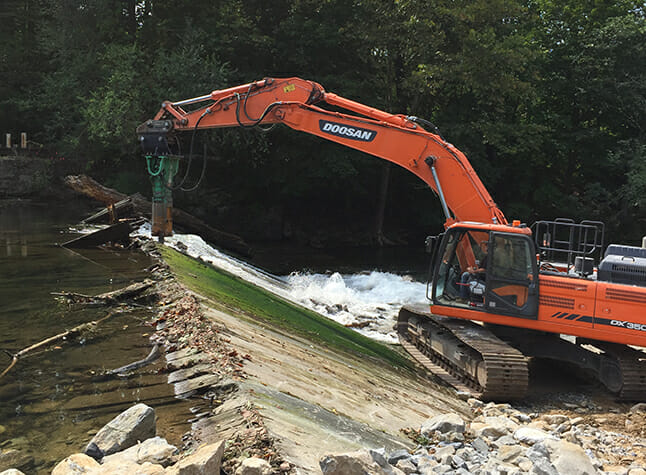An excavator begins work on removing the Hughesville Dam on the Musconecetcong River in New Jersey
By Cole Baldino
The American shad has been a staple of the eastern United States, especially the Delaware River, since early colonization. Some say those fish are part of the reason America is the way it is today, as George Washington and his troops relied on shad caught in Delaware River tributaries to fuel them through the Revolutionary War, saving the Continental Army from starvation in 1778.
Soon after, eastern colonization expanded and New Jersey’s longest tributary to the Delaware, the 48-mile Musconetcong River or ‘Musky,’ was dammed for purposes that are now obsolete, leaving the river impassable to shad and other migratory species.
Earlier this month, anglers fishing the Musky for trout and match the river’s prolific hatches found an unexpected surprise. Reports of small schools of shad above the Hughesville Dam site began to pile in to New Jersey’s Department of Environmental Protection (NJ DEP).
The return of shad to the Musky is a result of an effort over the past decade to strategically remove these remnant dams and return the Musconetcong River back to a free-flowing river.
Shad are an anadromous species, meaning they spend most of their lives in the Atlantic Ocean and migrate up the Delaware River and into the smaller tributaries each spring to spawn. Due to a high density of dams on the Musky, this ritual had been impeded. That was until the spring of 2017.
Starting closest to the confluence of the Delaware and Musky, a series of dams have been removed over the past decade, the most recent being the Hughesville Dam in 2016.
The Musconetcong River Restoration Partnership led the $1.5 million collaborative project to remove the Hughesville. Trout Unlimited and other partnering organizations watched the last piece of concrete fall in November 2016. The dam removals restored nearly six miles of free-flowing river before meeting the Delaware.
Rumors of the return of shad were recently confirmed as fisheries biologists with NJ DEP found shad immediately below the Partnership’s next target, the Warren Glen Dam.
At 32 feet high — more than double the height of the Hughesville Dam — the Warren Glen Dam is the largest dam on the river. Removal is expected to start in 2018 and will give great leverage to future dam removals on the Musky, throughout New Jersey and across the country.
The success stories of the Musconetcong Dam removals could not be possible without such a strong collaborative effort.
“This achievement is the direct result of an ongoing partnership among state and federal agencies, nonprofit groups, and dam owners – all committed to making this beautiful waterway free-flowing again,” said Bob Martian, DEP Commissioner.
Not only do dam removals affect shad, but nearly every other species that uses the Musky.
Trout gain unimpeded access to cooler waters in the summer and optimal spawning grounds in the spring and fall. Recreationists gain more scenic river miles to fish and boat.
Increasing numbers of other migrating species such as striped bass and American eel also can be expected.
Positives such as increased water quality and natural sediment transportation also stem from the efforts of dam removal.
Trout Unlimited is excited to continue its role within the Partnership and gladly welcomes the shad back to the Musky.
Cole Baldino is a new addition to the Trout Unlimited staff, serving as TU’s New Jersey Delaware River coordinator.



